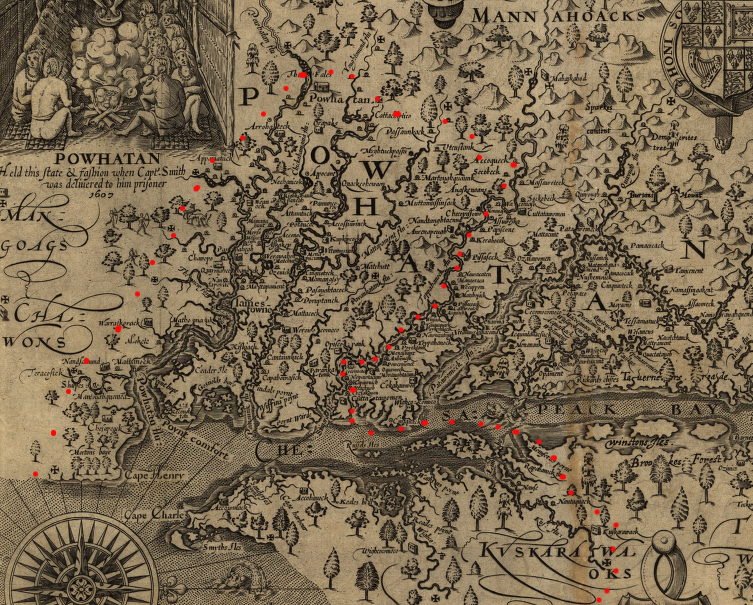
rough approximation of Powhatan's span of control in Tsenacommacah when the English arrived in 1607
Source: Library of Congress, Virginia / discovered and discribed by Captayn John Smith, 1606

rough approximation of Powhatan's span of control in Tsenacommacah when the English arrived in 1607
Source: Library of Congress, Virginia / discovered and discribed by Captayn John Smith, 1606
Wahasunacock, known to the English asc Powhatan, inherited control over just six tribes. He was successful in expanding the territory in which subordinate chiefs acknowledged his authority, and dominated over thirty tribes by the time the Susan Constant, Godspeed, and Discovery sailed into the Chesapeake Bay in 1607.
Powhatan's territory was called Tsenacommacah. It was roughly 80 miles long from Virginia Beach to Potomac Creek (in modern Stafford County), and extended 40 miles inland from the Eastern Shore to the Fall Line. His control on the southern edge of the James River was limited to essentially the watershed boundary east of the Fall Line. He controlled the mouth of the Appomattox River, but not the headwaters.
Almost all of Tsenacommacah was in the Chesapeake Bay watershed. The Nansemond and other tribes on the southern end of Tsenacommacah would travel across the watershed divide of the James River to hunt and gather in the Blackwater/Nottoway watershed. In addition, a small slice of the Eastern Shore and modern-day Virginia Beach drained into the Atlantic Ocean without going through the bay, but Tsenacommacah was centered on Tidewater rivers draining into the Chesapeake Bay.
Powhatan's "paramount chiefdom" was not isolated from other tribes. His emissaries interacted with other tribes to obtain status goods, including puccoon used to tattoo/dye the skin and copper from as far away as the Great Lakes. When relationships with the Siouan-speaking Manahoac and Monacans in the Piedmont soured, Powhatan could trade with Iroquoian-speaking tribes living in the Nottoway and Meherrin watersheds. Those tribes owed no allegiance to Powhatan, but business was business.
Iroquoian-speaking Cherokee traders from as far away as the Tennessee River would travel what became known as the Occaneechi Trading Path. Business was transacted often at the Occaneechi town on the shore of the Roanoke River near modern Clarksville, Virginia. It is possible that Powhatan could have enlisted help from those groups to expel the English immediately in 1607, if that had been the paramount chief's war aim.
It is also possible that Powhatan was primarily concerned about the other tribes west of the Fall Line and southwest of the James River watershed. The danger from one community of 104 settlers, who quickly revealed that they could not even feed themselves and died regularly from disease on Jamestown Island, may have paled in comparison to the threat from non-Algonquian tribes. As one scholar described it:1
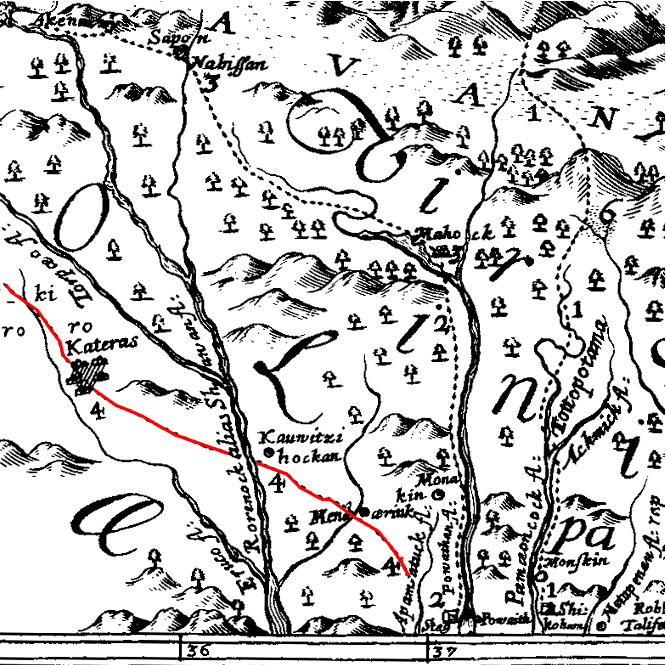
in 1672 John Lederer mapped the Occaneechi Trading Path, headed southwest from Powhatan's territory at Appomattox River across the Roanoke/Chowan river and through the Piedmont towards the Tennessee River
map has north to the right - and note "Powhatan R" (James River) above Appomattox
Source: University of North Carolina, The Discoveries Of John Lederer
Further north, settlers seeking religious separation from the Anglicans in England stepped off the Mayflower in 1620. They discovered Ousamequin, who the English called Massasoit, was the leader of the Wapanoag.
As the local sachem, he faced a dilemma similar to Wahasunacock/Powhatan. Over the last five years disease had reduced the population of the Algonquian-speaking Wapanoag by 90% while the Narragansetts that lived to the west had survived. Ousamequin/Massasoit felt more threatened by other Native Americans than by the 100 "pilgrims" - half of whom died in the first year.
The Wapanoag sachem chose to trade peacefully with the colonists, including the Massachusetts Bay Puritans who arrived in 1630 to build a "city upon a hill." The European and North American cultures managed to avoid major conflicts until Ousamequin/Massasoit died in 1661. His son Pometacom, known as King Philip to the English, finally launched a major attack to expel the English starting in 1675. By then the Native American capacity to control their territory was insufficient, and the colonists won King Philip's War.2
Within his society, Powhatan's span of control over his "paramount chiefdom" was established by force as well as by diplomacy. He permitted some tribes to maintain a high level of independence, but he attacked and physically eliminated the tribes occupying the tip of the Peninsula (site of the modern city of Hampton) and South Hampton Roads (Portsmouth/Norfolk/Virginia Beach ).
He destroyed the independent tribe on the Peninsula and placed his own son in charge of the town of Kecoughtan about 15 years before the English arrived. Powhatan purged the Chesapeake tribe around the time the English arrived, ensuring his control over the Elizabeth River watershed.3
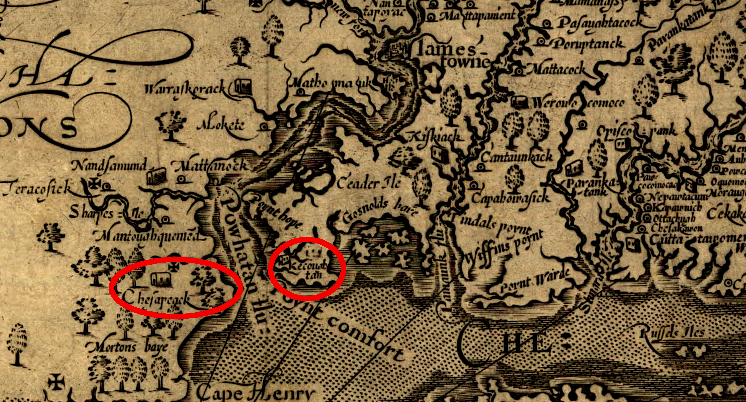
when the English arrived and intruded into the core of Tsenacommacah, Powhatan had already secured control over the Hampton Roads area by conquering and displacing the tribes at Kecoughtan and Chesapeake
Source: Library of Congress, Virginia (by John Smith, 1624)
Powhatan may have attacked the Chesapeake tribe because his priests had warned him that his control would be threatened from that location. On the other hand, he may have been thinking ahead and protecting the flank of his paramount chiefdom against some anticipated European threat. The Native Americans living along "Powhatan's flu" (today's James River) and Pamunkey flu to the north (today's York River) would have known stories of the Spanish Jesuits arriving in 1570.
In addition, the tribal leaders in Tsenacommacah would have known about English colonization attempts on the Outer Banks in the 1580's. Story-telling was a common entertainment in a society without television, so every Native American in the region probably heard tales about the unusual visitors in the past. The leaders would have known that the Native Americans had destroyed both the Spanish and English settlements.
The Algonquian-speaking tribes in eastern Virginia lacked over-the-horizon sensors to know exactly when European ships were headed towards Virginia, but Powhatan must have considered the possibility that ships from Europe could arrive in his territory again. By seizing control of the territory around Hampton Roads, he may have planned to keep the English on the Atlantic Ocean shoreline. That was at the periphery of his area of control, away from his most-valued towns and the spiritual center at Werowocomoco.
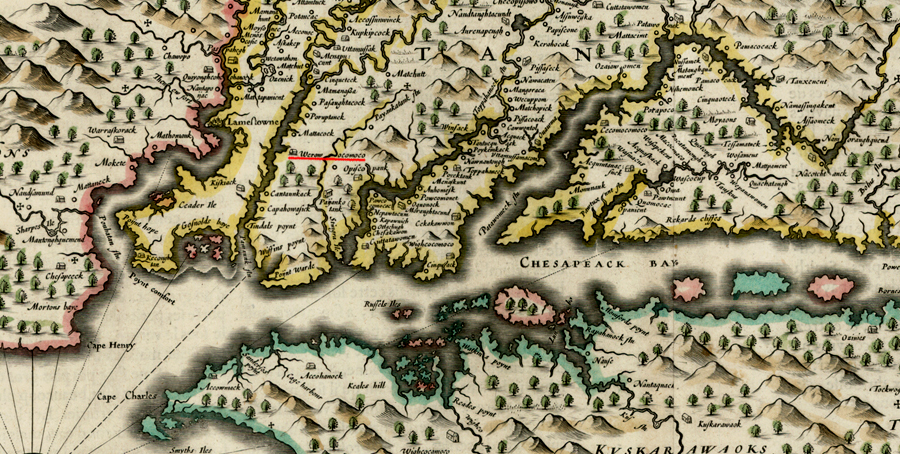
Werowocomoco was at the core of Powhatan's paramount confederacy, which stretched from the Rappahannock River to the southern side of "Powhatan's flu"
Source: Library of Congress, Nova Virginiae Tabula (by Willem Janszoon Blaeu, 1640)
Powhatan lacked the technology to block access to lands in the middle of his territory (Tsenacommacah), once the Susan Constant, Godspeed, and Discovery arrived. To the Algonquians, the English were "tassantassas" or trespassers in Tsenacommacah - but the Europeans were able to use their advanced technology (sailing ships) to go up Powhatan's Flu (James River) and settle right in the center of Powhatan's turf.
From the English perspective, Tsenacommacah was completely within the area claimed by the London Company through the First Charter issued in 1606. By right of discovery of lands unoccupied by Christians (and soon by right of conquest), the English could assert their ownership of Virginia. There was no need, from the English perspective, to buy a deed to the land from Powhatan.
The English had learned some lessons from the failure of the Roanoke Colony. They came prepared to disguise their intention from "the naturals" to occupy their land permanently. Instructions to the leaders of the 1607 colony included:4
In response to the English trespass, Powhatan practiced both crafty diplomacy and limited war. He carefully orchestrated his meetings with the English to establish his authority and to gain tactical advantages during negotiations. Powhatan refused to travel to Jamestown, and always made the English come to him.
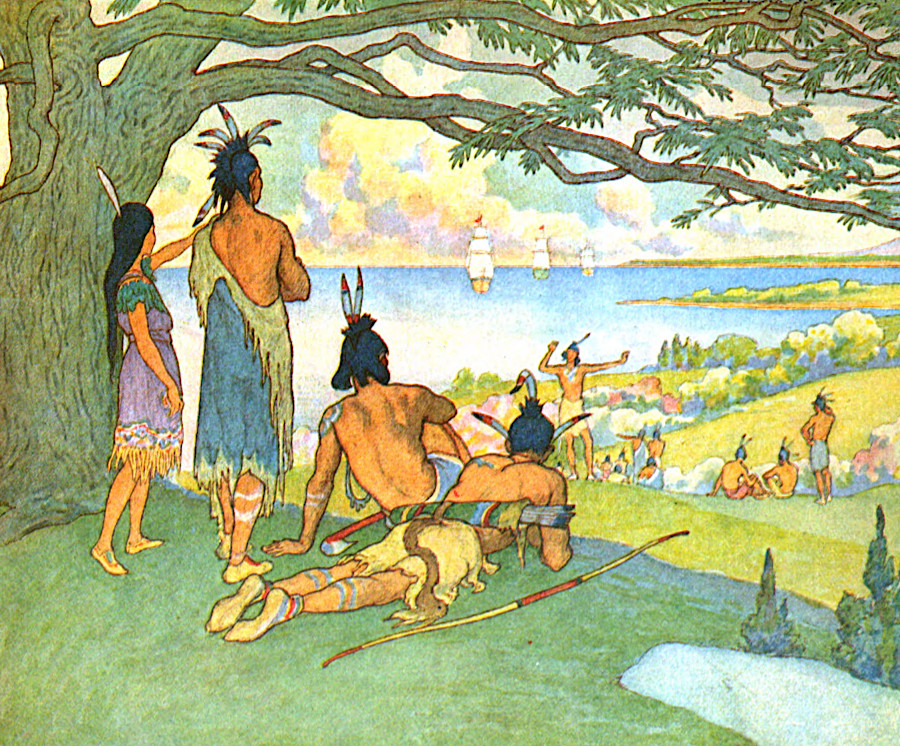
if the Paspahegh were excited when the English arrived, they were soon disappointed
Source: Elmer Boyd Smith, The Story of Pocahontas and Captain John Smith (1906)
He did not mass his warriors and try to expel the English as soon as they arrived. He sought to take advantage of the new arrivals, and make the foreigners subordinate to his control.
In 1608, Captain Christopher Newport returned to Virginia with orders to conduct a ritual with Powhatan that would define him as a subordinate of King James I. Newport sailed to Werowocomoco, where he had to use his one arm to lean hard on Powhatan's shoulder. That got the tall chief to bend down just enough for Newport to place a crown on his head.
Powhatan's gift back to Newport was asymmetric. He gave him a pair of worn moccasins and a "mantle," perhaps an old cloak that he wore to stay warm. Powhatan did not honor the "tassantassas" (strangers) and treat them as equals.
His gift to Newport may have been more comparable, if the 1608 mantle was the item now kept in the Ashmolean Museum of Art and Archeology in England. Documentation of its acquisition goes back to the 1630's, but "Powhatan's Mantle" could have been the gift to Newport. It consists of four decorated deer hides, sewn together and decorated with thousands of shells. It would not be practical to wear it, and was probably designed as a wall hanging to impress visitors with an object that had required a great deal of labor.5
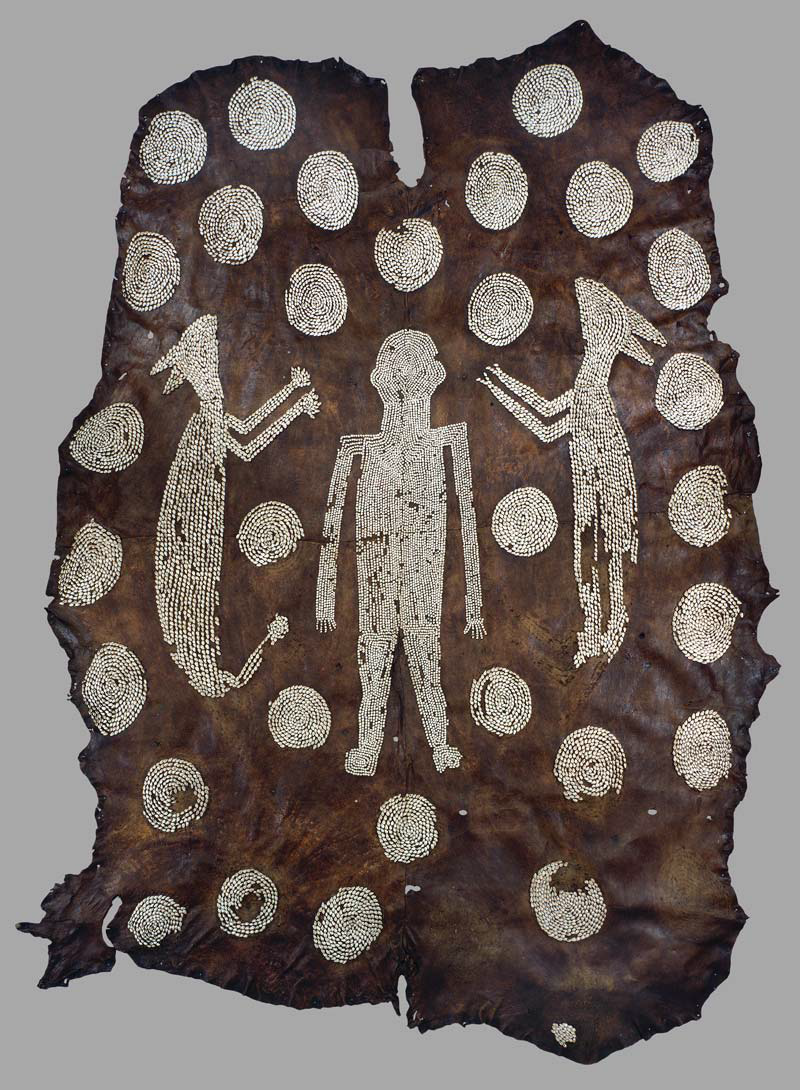
Powhatan gave Cristopher Newport old shoes and a "mantle," which may be this object at the Ashmolean Museum of Art and Archeology in England
Source: Virginia Indian Memorial Commission, Mantle: A Tribute to Virginia s Tribes
Powhatan was well aware of the technological advantages of the Europeans. Throughout his lifetime, ships had sailed into the Chesapeake Bay and up Tidewater rivers. Sailors had traded with the Native Americans, exchanging sharp-edged metal tools and prestige objects such as shiny glass for food and perhaps female companionship. The threat of guns and cannons had been displayed clearly, particularly by the Spanish in 1571 after they discovered the Jesuits priests at Ajacan had been murdered.
Powhatan also was aware of European culture and traditions. Paquiquineo had been taken away from the Peninsula by Spanish explorers in 1561 and spent the next nine years in Mexico, Cuba, and Spain. He returned with the Spanish Jesuits in 1570 and, to the great disappointment and ultimately fatal end of those priests, chose to rejoin his Algonquian community.
Paquiquineo would have told many stories to tribal leaders about his experiences with the Spanish. Powhatan must have quizzed him extensively, and it is possible that Paquiquineo was even his brother Opechancanough. Powhatan may have recognized that the English were different from the Spanish, but would have been well aware of the threat to his power from to the European culture of conquest and seizing the wealth of Native Americans.
The English attempted to disguise their intentions to make a permanent settlement from "the naturals," but Powhatan would not have been surprised. He was a leader savvy enough to gain control over over tribes and was not afraid of conflict, and he would have calculated the benefits as well as the risks of having the English in Tsenacommacah.
One reason Powhatan did not try to destroy the Jamestown colony immediately: he saw great value in having access to the European technology. He thought he could mitigate the dangers of having an independent power within his area of control, while gaining even more power and to expand the boundaries of his paramount chiefdom through acquisition of English weapons and trade goods.
The iron tools of the English were far more efficient than the stone/bone tools of the Native American culture. More importantly, English guns and swords were weapons of great utility, and if acquired by Powhatan's rivals he could lose his primacy. Powhatan's only opportunity to gain English weapons was through trade. Having an English base on the James River, filled with valuable weapons that the English were willing to exchange for food or in political negotiations, created the unique opportunity to obtain control over the most powerful technology for warfare.
The Algonquians valued shiny objects, which were rare in their culture, while the English had large quantities of polished copper and glass. Powhatan benefitted from obtaining prestige goods from Jamestown, but he did not need more prestige. His primary concern was to control the ability of other tribal chiefs to obtain prestige objects and become rivals to the paramount chief's authority.
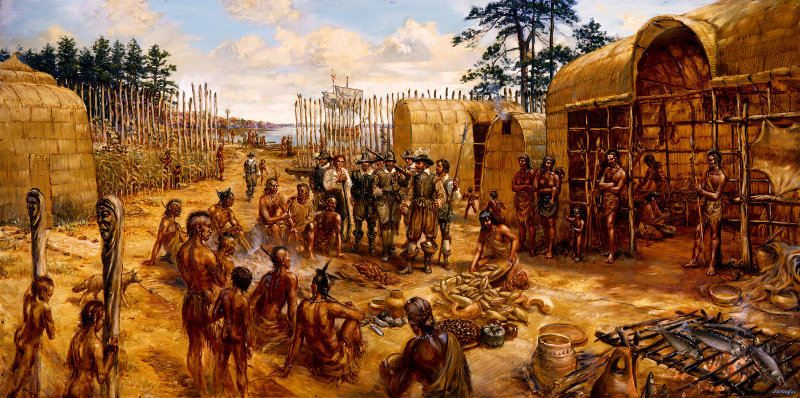
Powhatan did not exterminate the English when he had the opportunity, choosing instead to maintain trade
Source: National Park Service, Jamestown - Sidney King Paintings, Trading With the Indians
Accommodation with rival groups rather than direct conflict was not a new strategy for Powhatan. He had allowed the Chickahominy tribe to operate with semi-independent status in essentially the same area as where the English settled.
Powhatan tried to isolate the English from other tribes. If he could not expel the English from the banks of the James River, he could at least eliminate any possibility that they would find allies nearby. Most of what the English learned about the Manahoacs and Monacans came from Powhatan's people, and Powhatan made sure that English explorations west of the Fall Line were very limited.
Powhatan's efforts to isolate the English were only partially successful. John Smith and later Jamestown leaders were never able to build an effective alliance with the Monacan and Manahoac. The colony remained heavily dependent upon supplies from England, both food and manufactured goods (guns, ammunition, clothes, etc.).
Most of the English trade with the natives was limited to other Algonquian-speaking tribes who lived on the banks of the navigable rivers, where the English could use their ships to reach a town and carry away a heavy product such as corn. English ships allowed the "tassantassas" to reach the periphery of Tsenacommacah easily, and the Patawomeke in particular ended up demonstrating a willingness to ignore Powhatan's orders for a trade embargo when he tried to starve the English into submission.
Only after the Powhatan paramount chiefdom was destroyed did the English manage to establish a long-distance fur trading business beyond the Fall Line. The key trading centers were located at Fort Henry (modern Petersburg) and the town of the Occaneechi on the Roanoke River (modern Clarksville). Those two sites at the edge of Tsenacommacah duplicated key trading centers when Powhatan was in power.
The Algonquians practiced what today we call asymmetric warfare. Powhatan lacked guns and sailing ships, though Indian arrows were an effective weapon in the early 1600's. Native Americans could launch arrows faster than the first colonists could reload their guns, and the arrows penetrated the shields used by the English. In a direct confrontation, when enough English were present or swivel guns/cannons on ships could be utilized, European guns overwhelmed Algonquian arrows.
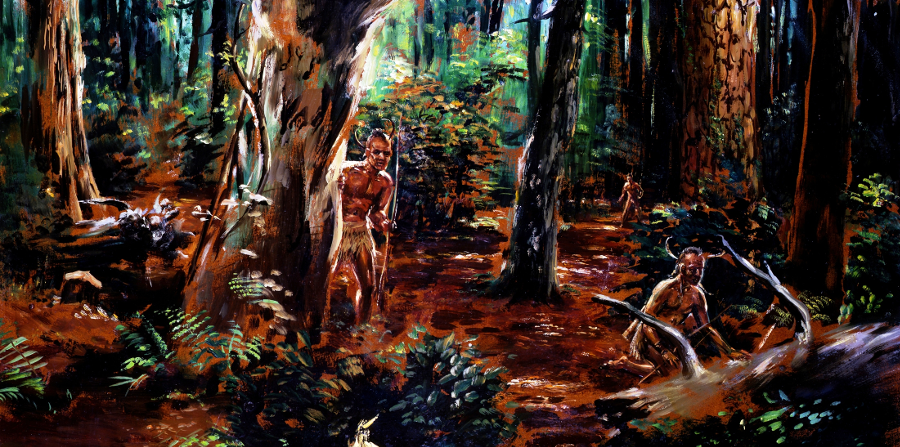
bows and arrows were effective weapons in the hands of trained and experienced warriors
Source: National Park Service, Jamestown - Sidney King Paintings, Outside the James Fort
Powhatan knew the local cultural landscape as well as the physical territory. With a few exceptions, he shaped the behavior of tribes in Tsenacommacah so the English remained dependent upon Powhatan's willingness to provide food. Because supplies from England did not arrive as planned, Jamestown settlers were unable to feed themselves. What Powhatan lacked in technology, he could make up for by controlling access to corn and meat from deer and turkeys.
Powhatan made calculations of the pros/cons for expelling the English, and it is likely that he applied Algonquian values and culture to the conflict. He may have planned for the English to become the equivalent to a subordinate tribe, part of the "family." The ceremony that John Smith described as a "rescue" by Pocahontas, before his brains were bashed in, may have been an adoption ritual. The English sought to make the Native Americans into their children, beholden to King James I as their new father. Powhatan may have used the same approach, attempting to make the English into his dependents.
After the adoption ceremony/rescue, John Smith would no longer have been a foreign invader, a threat to the paramount chief, but instead had become a lesser weroance who owed loyalty to Powhatan. After adoption, "bringing the English tribe back into the fold" could be accomplished by Powhatan applying pressure that demonstrated his displeasure and did not require sustained warfare.
In the early years of Jamestown, the risk of conflict with the Native Americans was always high. Colonists willing to plant and work the fields to grow food and tobacco were exposed to attack. A war of attrition ended up being to Powhatan's advantage in the early years of English occupation. His warriors numbered in the thousands, while the English population in the colony rarely exceeded 100 for very long.
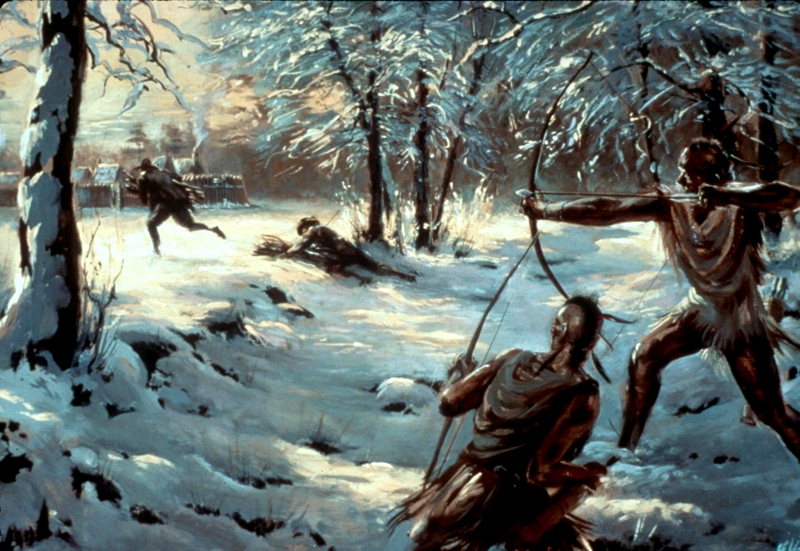
Powhatan's warriors could kill colonists when they left the fort to gather firewood or food
Source: National Park Service, Jamestown - Sidney King Paintings, A Dangerous Chore
In actual battle, Powhatan and his successors relied upon swift surprise attacks. Those killed a few people, but rarely forced a wholesale retreat by surviving English settlers.
The English military tactics relied upon larger search-and-destroy maneuvers, burning cornfields and towns to starve the assailants that they could not see. The English had no difficulty in destroying the traditional reed- or bark-covered huts in the Native American towns, but rarely were able to surprise and kill the residents. By destroying towns and crops, and by threatening raids that blocked food production, the English steadily forced different tribes to abandon their territories. Weapons based on gunpowder prevented the Algonquians from organizing a large number of warriors for an attack until 1622.
Random assaults between Native Americans and the colonists occurred since the very first landing of the English at Cape Henry. However, all-out war was not inevitable. Powhatan and John Smith might have reached a mutual agreement where they benefited each other, at least in the short run. As described in a Richmond Times-Dispatch column 400 years later:6
The English and Native American cultures were unable to establish a basis for peaceful coexistence in the areas occupied by English settlers. Cultures who can't cooperate... fight. Since it was the colonial settlements that changed conditions by pushing into Native American territory, it's fair to say that the English precipitated the conflicts.
The English and Native Americans had dramatically different concepts of "appropriate land use," in areas occupied by both groups. English pigs and cattle were perceived as "game" to be harvested by some Native Americans, while the English considered themselves entitled by their charter and English law to appropriate land in Virginia without compensating the Algonquian inhabitants.
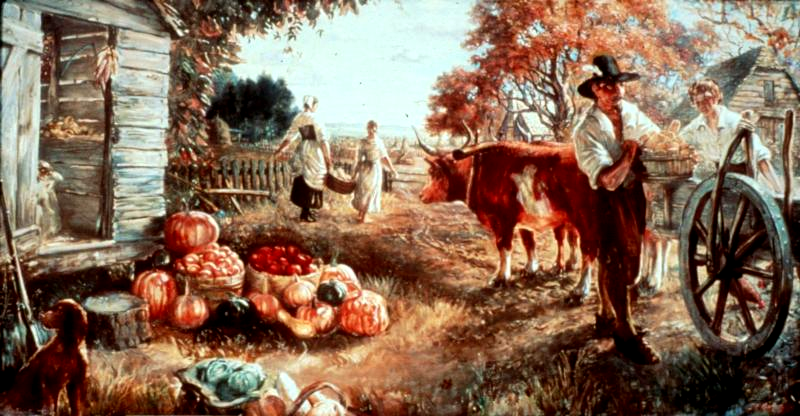
Native American farmers had no wheeled vehicles and no domesticated livestock
Source: National Park Service, Jamestown - Sidney King Paintings, Agricultural Beginnings
Native American town sites and cornfields were the most convenient areas to grow tobacco. The land was fertile and flat, and the trees had already been cleared - so the tobacco could grow in plenty of sunlight. On the other hand, the Native Americans could also trigger a fight. Killing English cattle was easier than hunting deer. Some of the English probably blamed every lost cow on the Native Americans, while some of the Native Americans probably blamed every hungry day on the English.
From Powhatan's point of view, the English were too hard to control. They kept trying to contact other tribes, evading Powhatan's schemes to steer all trade through him. In 1608 John Smith led two expeditions around the Chesapeake Bay, up the Potomac and Rappahannock rivers to contact rivals of Powhatan.
Christopher Newport led an exploration party that same year upstream of the falls on Powhatan's flu, later the site of Richmond. He visited with the Monacans, a Siouan-speaking group that regularly fought with Powhatan's Algonquian-speaking group. Powhatan's son Parahunt later sold the English the right to occupy the land next to his village at the falls of the James (which John Smith mapped as "Powhatan"), but the expansion of English occupation was a growing threat to Powhatan.
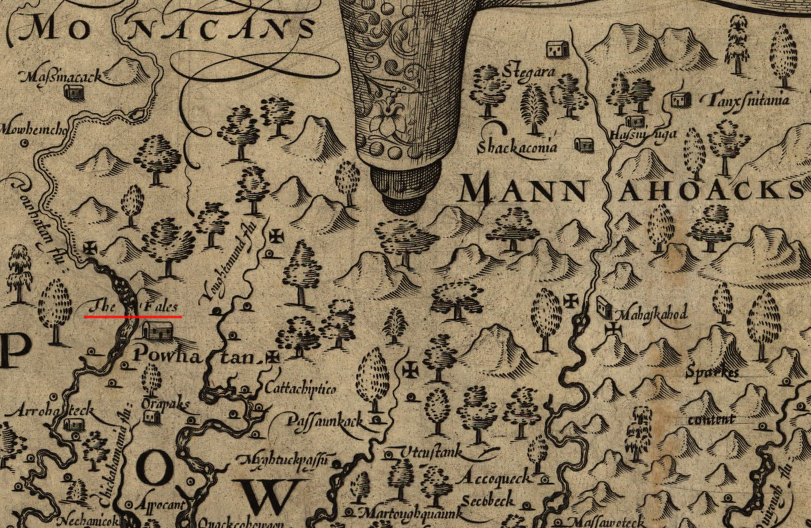
the English ignored Powhatan's concerns and made contact with his rivals, the Monacans, upstream of the Fall Line (where Richmond was later founded)
Source: Library of Congress, Virginia Discovered and Discribed by Captayn John Smith, 1606
While most of the early colonists died from disease, more kept coming from across the Atlantic Ocean. In 1609, most of the ships in the Third Supply arrived at Jamestown with 200-300 new colonists - but without Sir Thomas Gates, because the new governor had sailed on the Sea Venture. As the result of a hurricane, it was separated from the convoy and wrecked on Bermuda.
The new colonists in the Third Supply who made it through the hurricane to North America arrived in the Fall. They brought minimal supplies to feed them during the winter before new crops could be raised.
In a strategic decision, John Smith determined after the new colonists arrived that too many people were concentrated at Jamestown. The English were overwhelming the capacity of local tribes to raise surplus corn and to hunt enough deer to feed both the Native Americans and the colonists. Rather than just expand Jamestown, Smith decided to spread out and create new settlements up and down the James River, starting with territory controlled by the Nansemond tribe south of the James River.
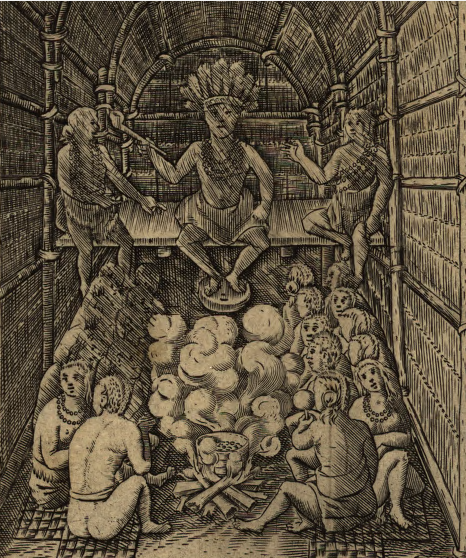
as portrayed on John Smith's map, Powhatan was a man of strength and authority
Source: Library of Congress, Virginia Discovered and Discribed by Captayn John Smith, 1606
In every war the other side can claim "he started it." The first Anglo-Powhatan war, starting in 1609, is no exception. Powhatan sought to achieve domination by starving the colony, once it became clear to him that Smith's strategy to shift the population out of Jamestown was incompatible with Powhatan's strategy of restricting settlement.
After John Smith was incapacitated by a gunpowder bag catching fire and burning his thigh, he sailed back to England. John Ratcliffe assumed the presidency, and led an expedition to Powhatan's new capital at Orapakes that ended in disaster for the English. Powhatan maneuvered Ratcliffe so the English were scattered and vulnerable on land, then killed 34 of the 50 in the party. Ratcliffe himself was captured and tortured to death, and the ship returned to Jamestown without food.
During the winter of 1609-10, known now as the "Starving Time," all but about 60 colonists staying at Jamestown died. Ratcliffe's replacement, George Percy, failed to move enough settlers away from Jamestown. He had Fort Algernon built at Kecoughtan (Point Comfort) and staffed that fort, where fish, oysters, and crabs were plentiful. The colonists there survived the Starving Time, but Percy failed to disperse enough colonists to other places besides Jamestown where food was available.
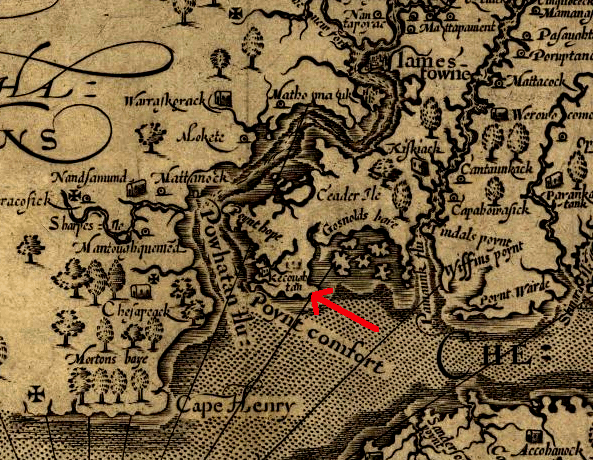
Kecoughtan
Source: Library of Congress, Virginia / discovered and discribed by Captayn John Smith, 1606
The arrival of Sir Thomas Gates from Bermuda in May, 1610 led to a major decision. In early June, 1610, the English abandoned Jamestown and started to sail home. After three years, Powhatan had won the first round, but it was a short-lived victory. Before the retreating English ships reached the Atlantic Ocean, they met Lord de la Warre leading a relief mission from England, and returned to Jamestown within two days under new leadership with new resources.
After the re-establishment of Jamestown, the English sought to trade with and then bluntly attacked the Nansemond tribe on the south bank of the James, down river from Jamestown. After wrecking their shrines and villages, the English returned to Jamestown.
In response, colonists living at Kecoughtan were killed. Thomas Gates then led an expedition that slaughtered the Kecoughtan tribe, and established a new settlement at the Kecoughtan village site on "Poynt Comfort." The City of Hampton can claim to be the oldest continuously-occupied English settlement in North America.7
Powhatan could not win a stand-and-fight battle, but he still had corn, furs and information to trade. His decision to allow the Chickahominy tribe its independence caused a setback, however.
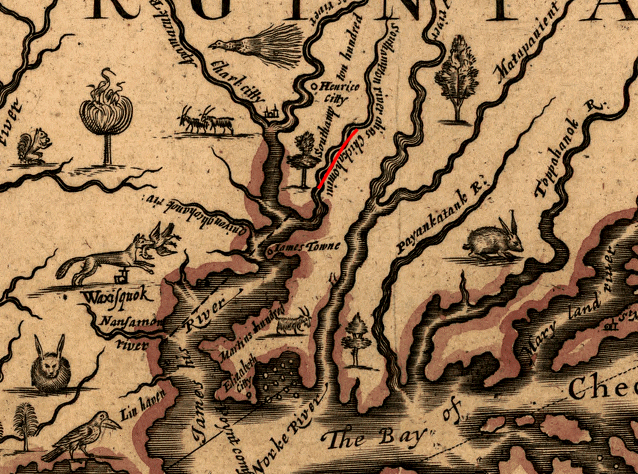
Chickahominy River upstream from James Towne on this 1667 map by John Ferrar
Source: Library of Congress, John Ferrar map of 1667 -
A mapp of Virginia discovered to ye hills, and in it's latt.
from 35 deg. & 1/2 neer Florida to 41 deg. bounds of New England
(compare with the modern map of this region from ArcGIS Online)
The Chickahominy reconsidered their semi-independent status with Powhatan after the English arrived. The Chickahominy saw the English displace the Paspahegh from their territory, and chose to become allies with the English in 1613. As described by John Smith:8
The edges of Powhatan's authority had been mapped by John Smith as he explored the Potomac River in 1608, and the Europeans understood the limits of Powhatan's power. Throughout the first Anglo-Powhatan War, the English evaded Powhatan's constraints and traded for corn with tribes willing to risk the displeasure of their paramount chief.
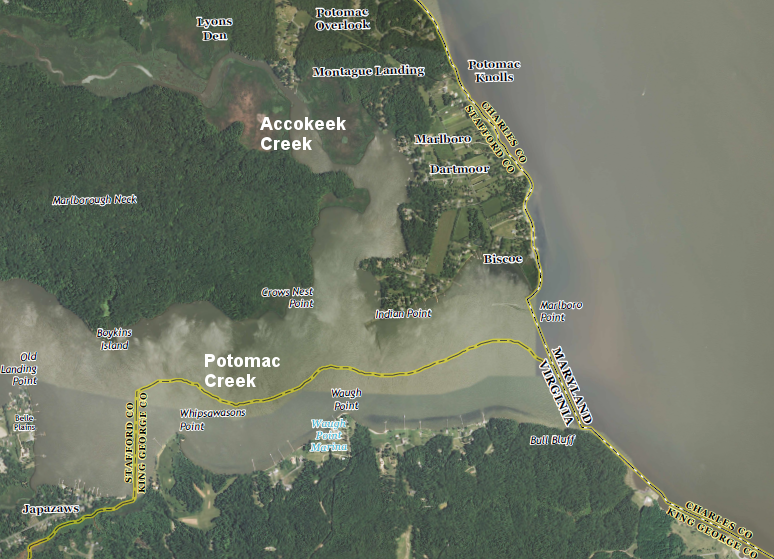
Pocahontas was captured at Indian Point at the mouth of Potomac Creek
Source: US Geological Survey (USGS), Passapatanzy 7.5x7.5 topographic quadrangle (2013)
Trade with the Patawomeck, located at the mouth of Potomac Creek in today's Stafford County, helped the English evade Powhatan's efforts to starve the Europeans. In 1613, one leader of the Patawomeck Tribe, Chief Japasaws, even went to far as to seize Powhatan's daughter when she was there on a "state visit" to strengthen Powhatan's control on the periphery of his area of control. Japasaws traded Pocahontas to an English sea captain, Samuel Argall, for a copper kettle.
At that point, Powhatan's daughter became a pawn in peace negotiations. Had Virginia been completely dominated by Powhatan, with the power to block the English from crossing outside his political boundaries, then Pocahontas would never have been captured or held captive.
Powhatan refused to trade for the hostage, even though Pocahontas was supposedly his favorite daughter. Her imprisonment in Virginia/English culture led to her decision to marry an Englishman, John Rolfe, in 1613. That marriage was a timely excuse for peace talks, since both Powhatan and the colonists were tired of the fighting. The "Peace of Pocahontas" ended the first Anglo-Powhatan War.
In 1614, the Virginia Company sent Pocahontas, John Rolfe, and their son Thomas Rolfe to England for a marketing tour. The visit of Virginia royalty was designed to advertise the opportunity to invest in Virginia, and to attract more immigrants to the colony. Sir Thomas Dale traveled back home with them.
His departure gave Opechancanough an opening to the Chickahominy. They had signed their treaty with the deputy governor based at Jamestown, and Opechancanough argued that the treaty was invalidated when Sir Thomas Dale left that position. The Chickahominy chose to switch sides and join Powhatan's paramount chiefdom in 1616. For the first time, they became part of Tsenacomoco.9
The English did not recognize that Opechancanough was preparing for a renewal of hostilities, and developing the alliances he would need before attacking the English settlements in an orchestrated assault.
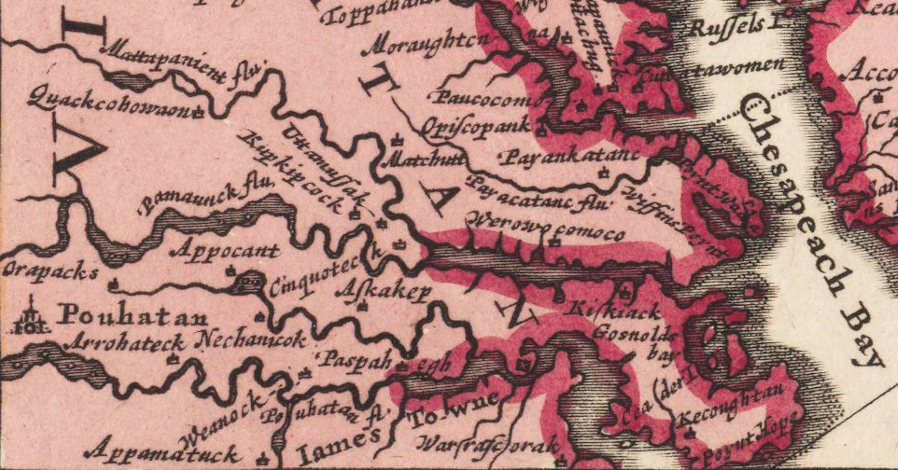
Native American towns surrounded Jamestown until the Anglo-Powhatan wars resulted in English dominance of the territory once controlled by Powhatan
Source: Harvard Map Collection, LinkBelgii novi, angliae novae, et partis Virginiae
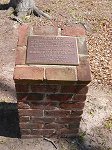 APVA sign |
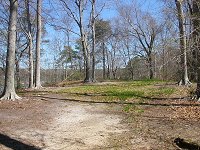 top of bluff |
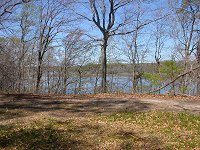 view of Grays Creek |
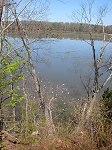 Grays Creek |
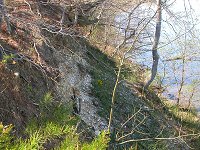 shell layer in bluff |
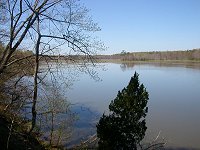 Grays Creek |